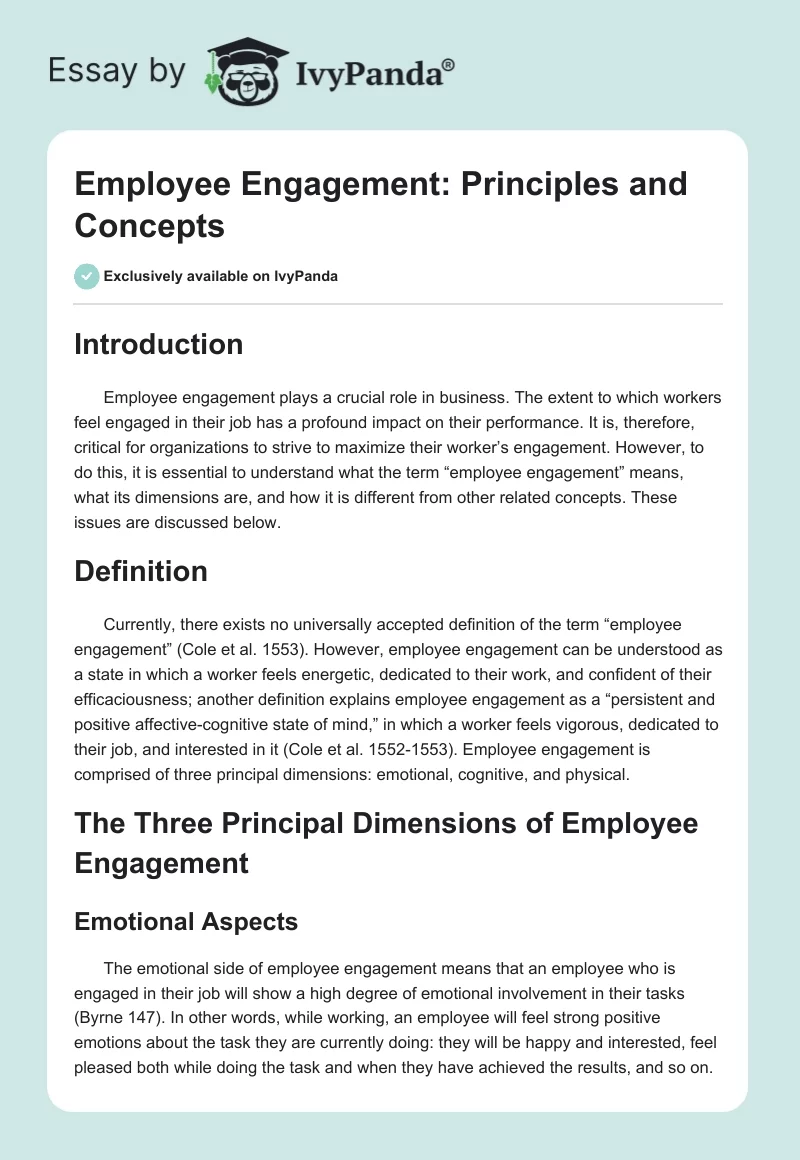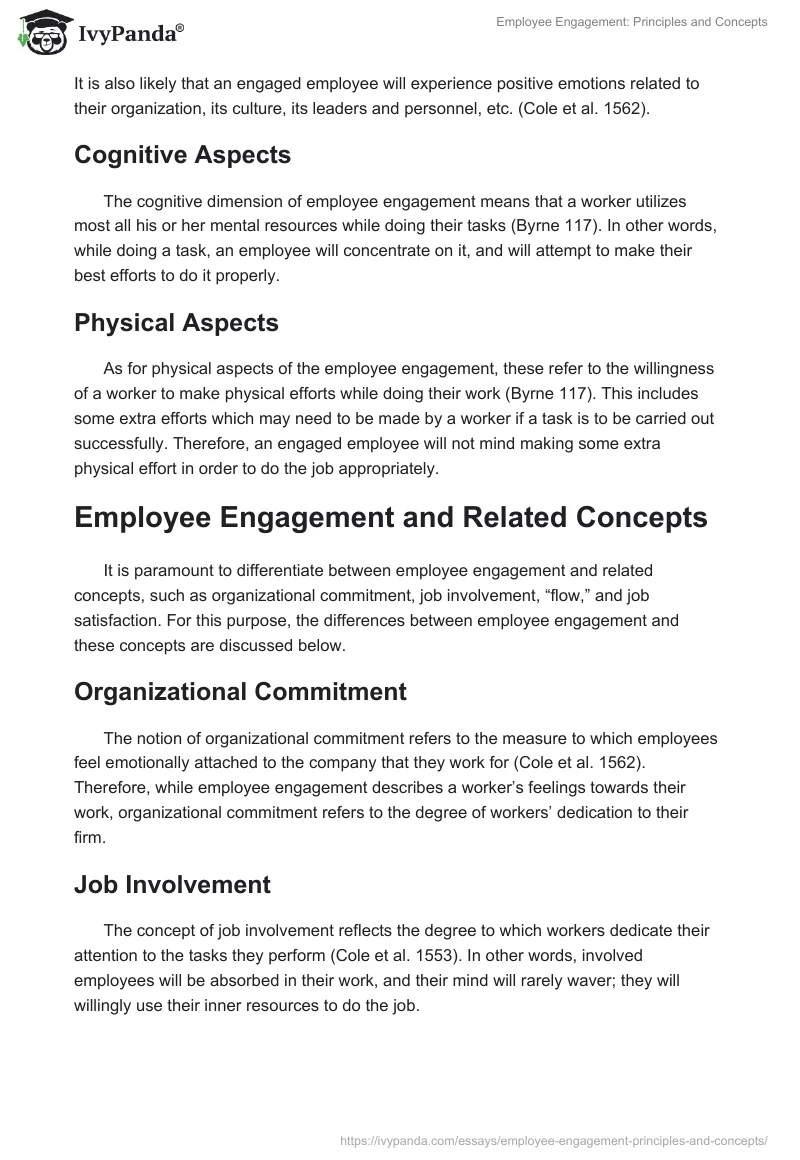Introduction
Employee engagement plays a crucial role in business. The extent to which workers feel engaged in their job has a profound impact on their performance. It is, therefore, critical for organizations to strive to maximize their worker’s engagement. However, to do this, it is essential to understand what the term “employee engagement” means, what its dimensions are, and how it is different from other related concepts. These issues are discussed below.
Definition
Currently, there exists no universally accepted definition of the term “employee engagement” (Cole et al. 1553). However, employee engagement can be understood as a state in which a worker feels energetic, dedicated to their work, and confident of their efficaciousness; another definition explains employee engagement as a “persistent and positive affective-cognitive state of mind,” in which a worker feels vigorous, dedicated to their job, and interested in it (Cole et al. 1552-1553). Employee engagement is comprised of three principal dimensions: emotional, cognitive, and physical.
The Three Principal Dimensions of Employee Engagement
Emotional Aspects
The emotional side of employee engagement means that an employee who is engaged in their job will show a high degree of emotional involvement in their tasks (Byrne 147). In other words, while working, an employee will feel strong positive emotions about the task they are currently doing: they will be happy and interested, feel pleased both while doing the task and when they have achieved the results, and so on. It is also likely that an engaged employee will experience positive emotions related to their organization, its culture, its leaders and personnel, etc. (Cole et al. 1562).
Cognitive Aspects
The cognitive dimension of employee engagement means that a worker utilizes most all his or her mental resources while doing their tasks (Byrne 117). In other words, while doing a task, an employee will concentrate on it, and will attempt to make their best efforts to do it properly.
Physical Aspects
As for physical aspects of the employee engagement, these refer to the willingness of a worker to make physical efforts while doing their work (Byrne 117). This includes some extra efforts which may need to be made by a worker if a task is to be carried out successfully. Therefore, an engaged employee will not mind making some extra physical effort in order to do the job appropriately.
Employee Engagement and Related Concepts
It is paramount to differentiate between employee engagement and related concepts, such as organizational commitment, job involvement, “flow,” and job satisfaction. For this purpose, the differences between employee engagement and these concepts are discussed below.
Organizational Commitment
The notion of organizational commitment refers to the measure to which employees feel emotionally attached to the company that they work for (Cole et al. 1562). Therefore, while employee engagement describes a worker’s feelings towards their work, organizational commitment refers to the degree of workers’ dedication to their firm.
Job Involvement
The concept of job involvement reflects the degree to which workers dedicate their attention to the tasks they perform (Cole et al. 1553). In other words, involved employees will be absorbed in their work, and their mind will rarely waver; they will willingly use their inner resources to do the job.
“Flow”
The term “flow” has been used to describe the sense of being so concentrated on one’s task that one stops being aware of other events around them, also losing track of time (Griffith). Thus, while employee engagement describes the long-term state of being energetic, vigorous, and dedicated to work, “flow” refers to the specific state of directing all of one’s attention to a current task.
Job Satisfaction
Job satisfaction is “the overall global feeling that results from the appraisal of one’s job experiences” (Cole et al. 1562). Therefore, while employee engagement reflects workers’ persistent, long-lasting feelings about their work, job satisfaction describes the results of employees’ assessment of the results of their work.
Conclusion
Therefore, employee engagement describes a persistent state in which a worker feels energetic, dedicated, and confident towards their job. It has three main dimensions (emotional, cognitive, and physical), and should be differentiated from other related concepts. It is crucial for organizations to maximize employee engagement in order to enhance workers’ performance.
Transferring the Obtained Knowledge into Working Practices
The knowledge gained while writing this paper can be used in working practices by attempting to enhance employee performance via addressing all the three aspects of employee engagement separately, but simultaneously. Differentiating between employee engagement and other related concepts might help to better understand the outcomes of the former.
Works Cited
Byrne, Zita S. Understanding Employee Engagement: Theory, Research, and Practice. Routledge, 2015.
Cole, Michael S., et al. “Job Burnout and Employee Engagement: A Meta-Analytic Examination of Construct Proliferation.” Journal of Management, vol. 38, no. 5, 2012, pp. 1550-1581.
Griffith, Terri. “Help Your Employees Find Flow.” Harvard Business Review. Web.


